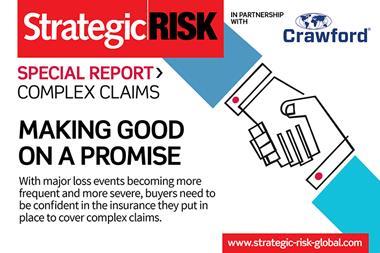It is in how they manage blindsiding losses that the risk managers prove their mettle
Major and complex claims can make or break an organisation. It is in how they manage these blindsiding losses where the risk and insurance manager proves his or her worth.
“Nothing helps you gain a better reputation than if you help to get a large claim paid out,” says Alexander Mahnke, CEO of Insurance at Siemens and chairman of GVNW. “This is when your Board really appreciates that you’re there.”
“The insurance and risk manager needs to be at the core of everything,” he continues. “This is where we have to prove our value to the company and our counterparties, because usually you don’t just deal with one insurer, you deal with multiple insurers.”
“You need to be the interface between the business that has suffered the loss and all the different stakeholders. You need to communicate what information needs to be gathered, how to prove this is an insured claim under the terms of the contract, and you have to manage the expectations of all parties.”
Keeping the ball in the air
Key to the successful management of a large and complex claim is planning. Sitting down with all major stakeholders to test out various loss scenarios and test how insurance programmes are likely to respond offers valuable insights.
It also gives you the opportunity to assign responsibilities to all parties, set goals and discuss communication protocols.
“Handling a complex claim will often last 12-36 months and the most effective lines of communication need to established from the start, developing trust and understanding how the business operates are critical in achieving a favourable outcome,” says Glenn Thornton, head of general property and major and complex loss at Crawford & Company.
“Working with the insured, exploring options and being sympathetic to the needs of the business helps create a partnership which will often result in a reduced indemnity spend as the business recovers quicker.”
Scenario planning and portfolio stress testing needs to be part of the company’s overall crisis management process, thinks Thornton.
“The pre-loss work will speed up this process with the understanding of the business, communication lines already agreed and an understanding the key drivers of the business. The potential weakness may have already been exposed and processes modified to reduce future risks if the worst should happen.”
Corporate risk managers therefore need to be selective when choosing insurance and broker partners in the first instance.
“I like to talk to our client managers, but I think it’s more important to talk to the underwriters and the claims people. And it’s also important that they talk to each other as well,” says Mahnke. “I’ve never understood companies that did not insist on meeting the claims people.”
“When you pick your insurer it is of the utmost importance to understand how they are going to fulfil their claims promise, and this doesn’t apply only in hard markets. We keep telling our [GVNW] members this is the most important thing,” he continues.
“A large claim is a very stressful event and experience, and you want to be surrounded by professional people who know what they are doing, and you want to know beforehand what you can expect and if you need to seek help elsewhere.”
What about the data?
Nobody wants to experience a major loss and yet the reality for most large multinationals is that operating in a highly interconnected and increasingly risky and uncertain world means that losses are becoming more frequent and severe.
From a resilient perspective, the loss data that is captured can be critical in spotting patterns of vulnerability, which can then be addressed.
“Prevention is always better than cure,” says Mahnke. “It helps to learn from losses you’ve had in the past to make sure this doesn’t happen again. The more data on losses you have had, the better you can argue that certain scenarios are in trouble and should be insured so you can market your risk in the most efficient and successful way.”
For companies that self-insure and use captives to incubate emerging risks, where solutions are not readily available in the commercial insurance market, it is essential to capture all relevant loss data. This includes data from ‘near misses’ and uninsured losses.
“Near misses are not always talked about in the right manner,” says Mahnke. “If you start measuring uninsured risk you can make a financial argument about prevention and how insurance has helped you do the right thing in a company. I know of companies that use dashboard systems with near misses that help them argue their case very effectively to their board.”
Over the past couple of years, there has been a broad acceleration of digitisation, with adoption of cloud technologies and wider investment in technology platforms and analytics. Insurance has always been a data rich industry, but it has never been better placed to extract insights from that data.
Leveraging data from insurance partners and loss adjusting firms is important. Corporate risk managers typically only have insights into their own operations, whereas insurers, brokers and loss adjusters can show the bigger picture.
For SMEs that lack internal resources, brokers should be proactively offering these insights
This can include the types of loss most frequently seen at an industry or regional level, for instance, along with emerging trends. It can reveal common sources of large losses within a sector, as well as supply chain bottlenecks and which areas becoming more vulnerable to extreme weather, among other things.
Using such data in combination with risk engineering advice can help build greater resilience.
Building back better
The topic of resilience in the face of climate change has never been more relevant from a claims perspective.
With the IPCC warning we should expect more frequent and intense weather-related events going forward, and the memories of major catastrophes in 2021 still fresh, it is increasingly clear that post-event restoration must include investment to ‘build back better’.
This is where the insurance industry has a pivotal role to play, thinks Mahnke. “This is the ‘E’ part of the ESG topic - when insurance can help building back or building better - more efficiently and more sustainably. To date, it has not reflected in most insurance contracts but it’s something we need to talk about.”
He refers to the catastrophic floods that devastated large parts of Germany in July as an example of the type of extreme event we can expect to see more of in the future. “The recent floods have helped galvanise the necessity of that sort of discussion. If you look at what has happened in Germany - we all knew about the potential for flood - but if affected villages and houses that had been around for centuries.”
“Overall, ‘building back better’ is a description of how the insurance industry can help to contributing more sustainable societies and economies,” adds Mahnke.
Currently, when a flood occurs, most insurers look to reinstate properties on a like-for-like basis. But this could potentially leave homes and commercial buildings vulnerable to repeat flooding in the face of a changing climate.
“We are experiencing a proliferation of events across the world and rain bombs in particular can lead to flooding in locations which were traditionally never considered at risk,” says Crawford’s Thornton.
“The opportunity from claims is therefore to signpost the future risks and how future resilience can be incorporated within repair and refurbishment projects.”
In the UK, insurer Zurich has launched a scheme that sets out of a formal process for loss adjusters to follow following a flood event. It will ensure resilience is considered as part of every claim assessed going forward and will include installing air brick covers, non-return valves and flood doors or barriers.
In areas where flood risk levels are high, the UK government is being called to make flood resilience grants available upfront. “Although we can’t prevent flooding, we can ensure properties are better protected,” said Paul Redington, Zurich’s regional major loss property claims manager. “We’ve transformed the way we handle claims to help flood-hit customers build back better.”
The steps follow calls by Flood Re to use property flood resilience measures for building repairs. Speaking at COP26, the scheme’s CEO Andy Bord said there needed to be a continued, long-term commitment to flood defences, including the use of natural flood management approaches.




















No comments yet